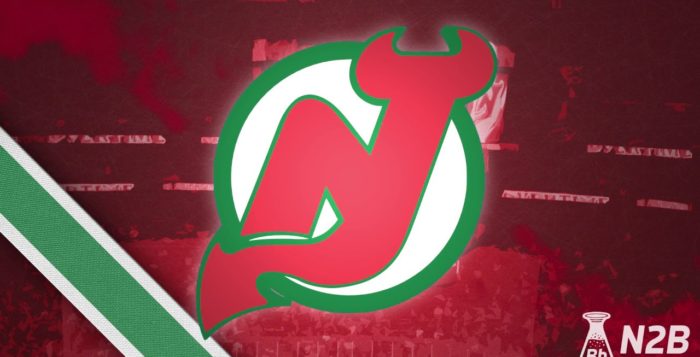This Day in Hockey History – June 30, 1982 – Speak of the Devils
Third time must have been the charm. The struggling franchise moved from Kansas City to Colorado to New Jersey, where on June 30, 1982, the team was named the Devils.
Kansas City, Missouri received an NHL franchise on June 8, 1972, as part of an expansion meant to combat the rival World Hockey Association (WHA). The Scouts played their first game on October 9, 1974. However, they had two poor seasons that barely filled their arena halfway, and they owed money to the NHL and nearby St. Louis Blues. Thus, instead of expanding into Denver in 1976, the NHL moved the Scouts to Colorado.
The Colorado Rockies spent six seasons in Denver, but they only made the playoffs once. When he bought the franchise in 1978, Arthur Imperatore planned to move the team to his home state of New Jersey. It took three tries before relocation went through. During Imperatore’s time, the main issue was that the arena at East Rutherford, New Jersey would not be built in time, and his proposal to temporarily share Madison Square Garden failed. The next owner, Peter Gilbert, also tried to relocate, but the NHL wanted to keep a franchise in Denver. Having lost about $4.5 million on the team in 1981-82, Gilbert sold to John McMullen and his group.
Finally, the NHL approved the relocation with the stipulation that McMullen pay over $20 million in territorial compensation fees because three big franchises already played in the area (the New York Rangers, the New York Islanders, and the Philadelphia Flyers). New Jersey joined the Patrick Division, and the Winnipeg Jets moved from the Norris to Smythe Division after the Rockies left.
As many new and relocated teams did, New Jersey held a “Name That Team” contest. The statewide contest featured 11 names and some write-ins. With over 10,000 ballots cast, the Devils came out on top with 2,400 votes. The runner-up, Blades, received 1,700 votes. The other names up for consideration included, Meadowlanders, Colonials, Americans, Meadowlarks, Lightning, Coastals, Generals, Gulls, Jaguars, and Patriots.
At the press conference held at Brendan Byrne Arena of the Meadowlands Sports Complex in East Rutherford, McMullen announced that the team would be known as the New Jersey Devils. He said, “According to Webster’s dictionary, one of the definitions of devil is ‘a person of notable energy, recklessness, and dashing spirit. I’m very pleased with it in spite of the fact we didn’t think of it ourselves.” Unsurprisingly, he received some letters and calls due to the negative religious connotations, including one sportswriter being called “an agent of Satan.” Surprisingly, New Jersey Sports and Exposition Authority reps actually conferred with clergymen, who didn’t object. Goalie Chico Resch joked, “I’ve always said I thought goalies were God’s chosen people. We’re the only people that, when we sin, the red light goes on and you hear sirens.”
The new name actually referred to the legendary Jersey Devil. Similarly, an Eastern Hockey League team had played under the name Jersey Devils from 1964 to 1973. The Jersey Devil, often called Leeds Devil, was a mythological beast described as “part dog, part kangaroo, part goat, and with cloven feet.” According to the folklore, since the 1730s, he has roamed the Pine Barrens of South Jersey frightening folks or worse.
To go with the new name, the team chose the color red. They added dark green to represent the Pine Barrens and their location in the Garden State. At the time, these “Christmas colors” were unique in the NHL. The inconsistency of the green color led them to switch to black in 1992. A simple “N” and “J” with devil horns and tail form the team logo. It was modified from the one designed by McMullen’s wife around the time of the 1982 relocation.
After winning three Stanley Cup championships – in 1995, 2000, and 2003 – the Devils moved from East Rutherford to Newark, New Jersey in 2007. Since then, they have made the playoffs in five of twelve seasons, while one of those included the Stanley Cup Final. During years without playoffs, rumors of relocating yet again rise, and some even mention returning to Kansas City. Despite financial struggles and injuries, the Devils cannot be counted out yet. They just recently had the No. 1 pick at the 2019 NHL Entry Draft, so who knows what future is on the New Jersey horizon.
Additional Sources:
- Stephen Laroche, Changing the Game: A History of NHL Expansion(Toronto: ECW Press, 2014), 234-237.
- Hockey Chronicle: Year-by-Year History of the National Hockey League (Lincolnwood, Ill.: Publications International, Ltd., 2006), 438.
- Tim Sullivan, Battle on the Hudson: The Devils, the Rangers, and the NHL’s Greatest Series Ever (Triumph Books, 2012), kindle version.
- https://www.nytimes.com/1982/06/30/sports/scouting-jersey-devils-wins-name-poll.html
- Sherry Ross, “N.J. fans go to the Devils,” Hackensack Record, 1 July 1982, pp. C1 and C7.














